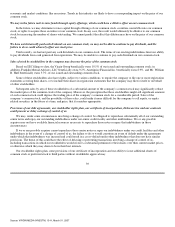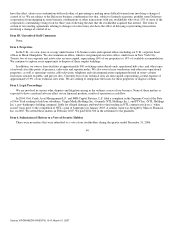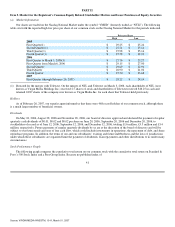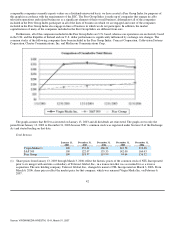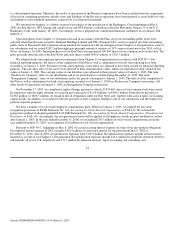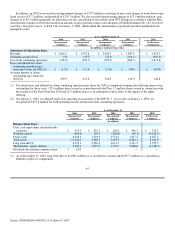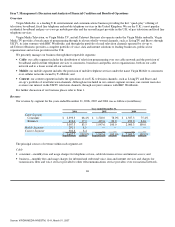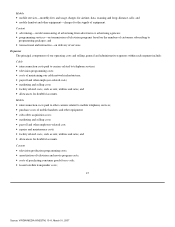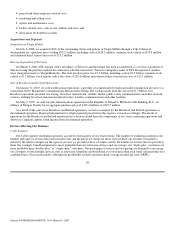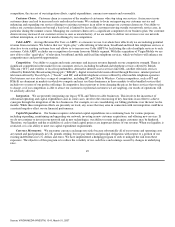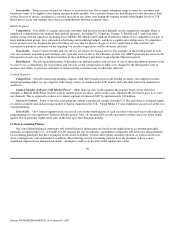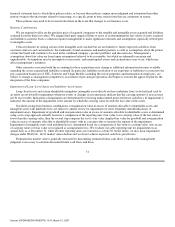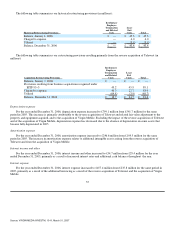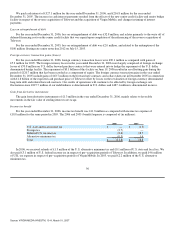Virgin Media 2006 Annual Report Download - page 53
Download and view the complete annual report
Please find page 53 of the 2006 Virgin Media annual report below. You can navigate through the pages in the report by either clicking on the pages listed below, or by using the keyword search tool below to find specific information within the annual report.
competition, the success of our integration efforts, capital expenditures, currency movements and seasonality.
Customer Churn. Customer churn is a measure of the number of customers who stop using our services. An increase in our
customer churn can lead to increased costs and reduced revenue. We continue to focus on improving our customer service and
enhancing and expanding our service offerings to existing customers in an effort to manage our customer churn rate. Our ability to
reduce our customer churn rate beyond a base level is limited by factors like customers moving outside our network service area, in
particular during the summer season. Managing our customer churn rate is a significant component of our business plan. Our customer
churn rate may increase if our customer service is seen as unsatisfactory, if we are unable to deliver our services over our network
without interruption, or if we fail to match offerings by our competitors.
Cable ARPU. Average Revenue Per User, or ARPU, is a measure we use to evaluate how effectively we are realizing potential
revenue from customers. We believe that our “triple−play” cable offering of television, broadband and fixed line telephone services is
attractive to our existing customer base and allows us to increase our Cable ARPU by facilitating the sale of multiple services to each
customer. Cable ARPU excludes any recognition of revenue from our Mobile segment. With the acquisition of Virgin Mobile we are
now able to offer “quad−play” of television, broadband, mobile and fixed line telephone services, which we believe will enhance our
competitiveness and growth opportunities.
Competition. Our ability to acquire and retain customers and increase revenue depends on our competitive strength. There is
significant competition in the market for our consumer services, including broadband and telephone services offered by British
Telecom (“BT”) and resellers or local loop unbundlers, alternative internet access services like DSL, satellite television services
offered by British Sky Broadcasting Group plc (“BSkyB”), digital terrestrial television offered through Freeview, internet protocol
television offered by Tiscali S.p.A. (“Tiscali”) and BT, and mobile telephone services offered by other mobile telephone operators.
Our business services also face a range of competitors, including BT and Cable & Wireless. Certain competitors, such as BT and
BSkyB, are dominant in markets in which we compete and may use their dominance in those markets to offer bundled services that
include two or more of our product offerings. If competitive forces prevent us from charging the prices for these services that we plan
to charge, or if our competition is able to attract our customers or potential customers we are targeting, our results of operations will
be adversely affected.
Integration. We are presently integrating our legacy NTL and Telewest cable businesses. This involves the incurrence of
substantial operating and capital expenditures and, in some cases, involves the outsourcing of key functions in an effort to achieve
synergies through the integration of the two businesses. For example, we are consolidating our billing platforms over the next twelve
months. While these integration efforts are presently on track, any issues that may arise in connection with our integration could have
a material negative effect on our financial performance.
Capital Expenditures. Our business requires substantial capital expenditures on a continuing basis for various purposes,
including expanding, maintaining and upgrading our network, investing in new customer acquisitions, and offering new services. If
we do not continue to invest in our network and in new technologies, our ability to retain and acquire customers may be hindered.
Therefore, our liquidity and the availability of cash to fund capital projects are important drivers of our revenue. When our liquidity is
restricted, so is our ability to meet our capital expenditure requirements.
Currency Movements. We encounter currency exchange rate risks because substantially all of our revenue and operating costs
are earned and paid primarily in U.K. pounds sterling, but we pay interest and principal obligations with respect to a portion of our
existing indebtedness in U.S. dollars and euros. We have implemented a hedging program to seek to mitigate the risk from these
exposures. The objective of this program is to reduce the volatility of our cash flows and earnings caused by changes in underlying
rates.
49
Source: VIRGIN MEDIA INVESTM, 10−K, March 01, 2007


